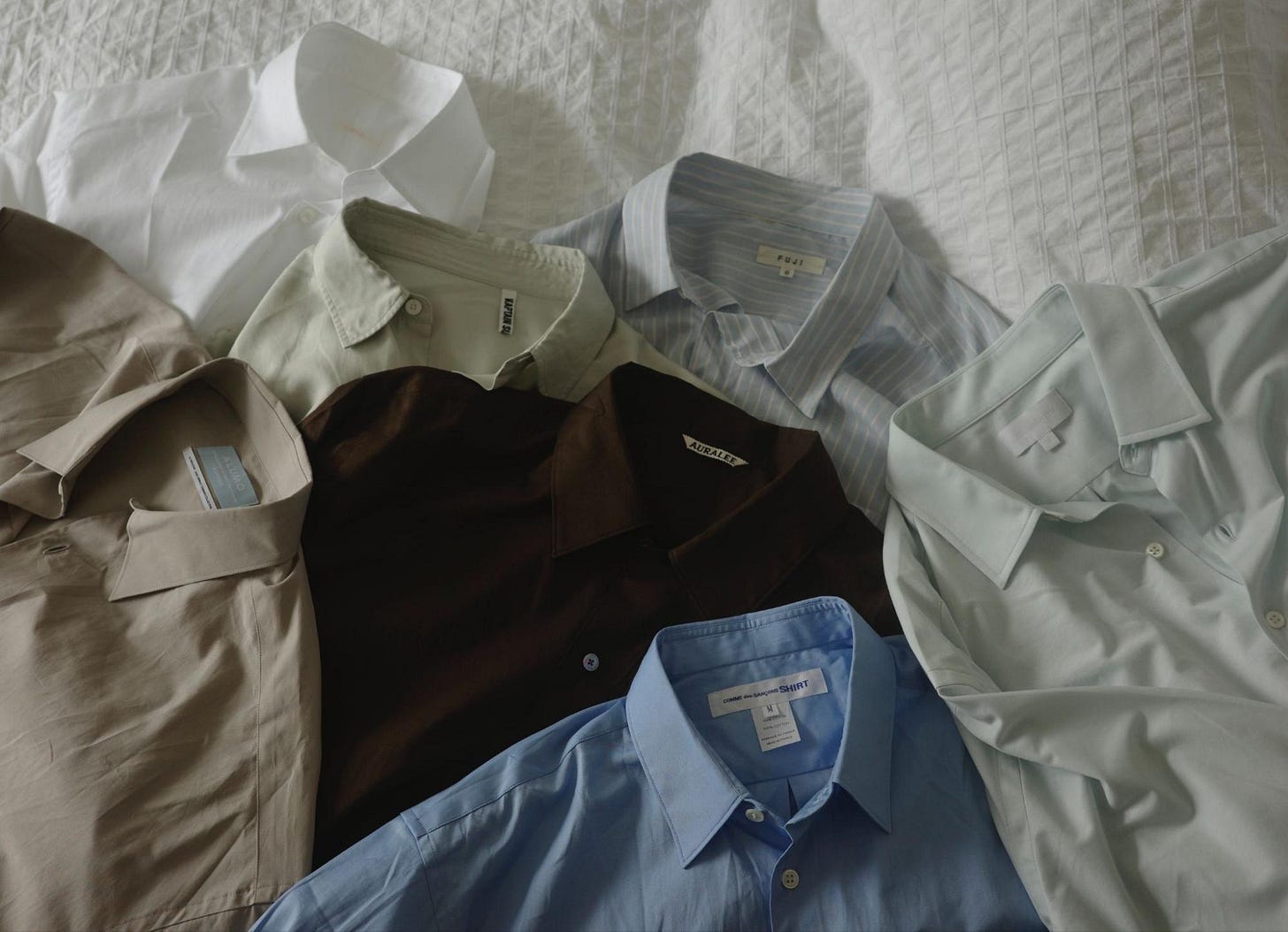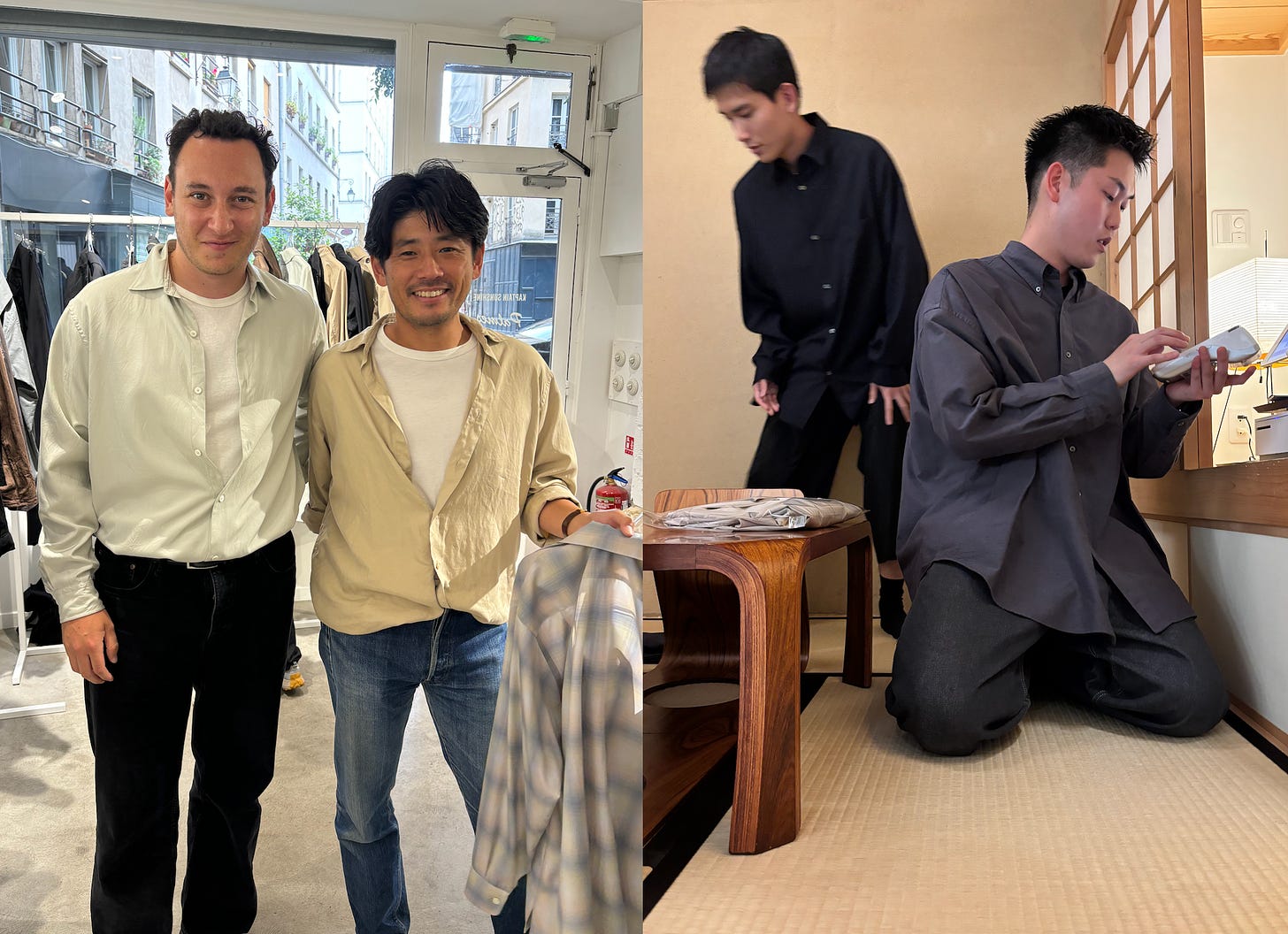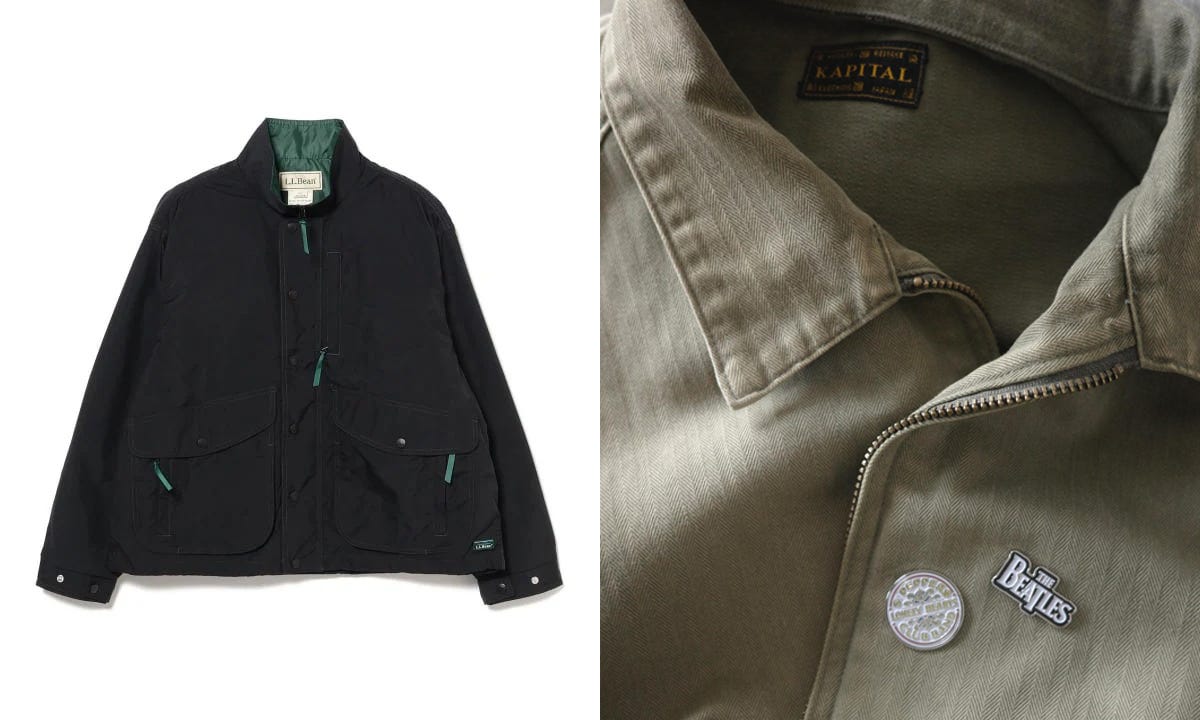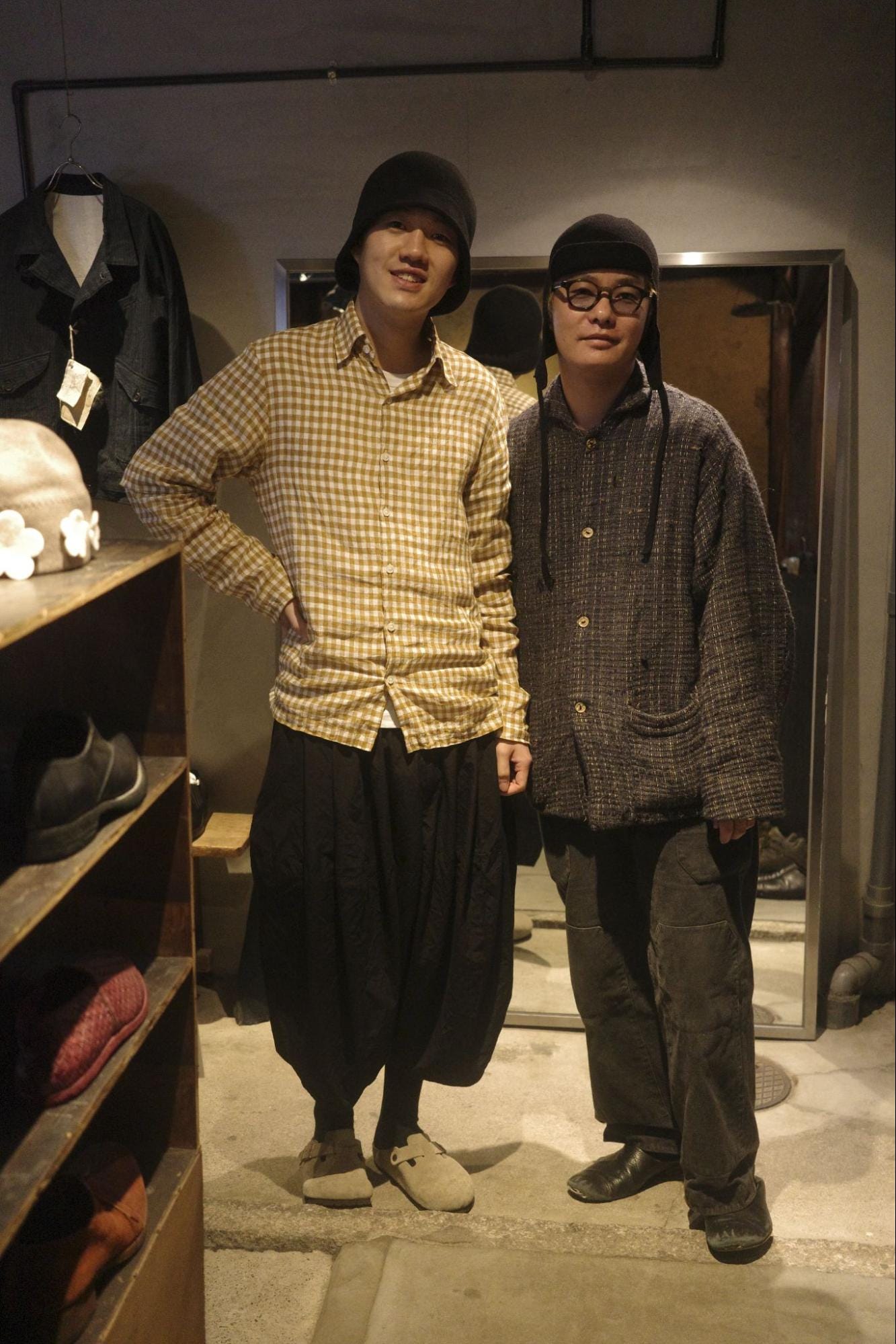362: Big (shirt sizes) in Japan
And how Kyohei Yamashita wears it.
Welcome to Magasin Menswear. In a dedicated bimonthly send, Louis Cheslaw surfaces choice products worth your consideration, explores larger conversations shoppers are—or should be—having, and taps a smart dresser to share how he wears it.
First up…
The Lemaire bag that got multiple nods in last month’s send? Unexpectedly back in stock.
Also in stock, at least for now: Body of Work’s collaboration with Mephisto—the first time the Match has been offered in suede rather than leather.
After last send’s bag reporting, I sprung for a vintage Henry Cuir/Henry Beguelin tote for myself via eBay. (I really love it, and another friend is equally thrilled with theirs from TheRealReal, which is similar to this still live one.) That’s two for two on the brand’s archive pieces, then—or four for four, if we’re including Addison and Alexa. Before picking mine, I had these two on my watchlist as well, but both have since sold. Seems now is the time to hunt your Henry.
Emily Dawn Long tells me she’s opened her New York studio for appointments. “I really wanna get away from ONLINE,” she says. “I love learning what customers love and need and are missing. So now my brain and my world are open on select days of the week to come in, try things, see the collection.” It sounds like fun: “Some people are shy, but I’m like ‘Hi, I broke my toe, what’s up?!’ And then we chat for 45 minutes, and now we’re besties.”
In other New York news, The Ouze is popping up at Colbo until June 2. Go meet Toby.
A few years ago, Shiro sent me two pairs of their 1992 gym sock; I still wear them. Love how they’ve aged, and have been poking the brand for restock info recently. They’re finally back. (FWIW, I believe Lawrence Schlossman and Kathleen Sorbara are also fans.)
Because I’m weird, I spent a recent Saturday afternoon trying different canvas sneakers—including Converse Chuck 70s, Anatomica deck shoes, and Vans Authentics—just to conclude that the ripped, stained, but totally intact Doek Court shoe I wrote about last summer (and wore the two summers before that) will once again be my summer go-to.
I don’t really want to wear jeans this summer. For one, I won’t feel comfortable, but they’re also all I’ve worn for the past nine months. Motivated partly by this, and partly by Laura’s incredible recent index, I took inventory of my black trouser collection. (It didn’t take long, I had none.) So in Tokyo last week, I bought two non-branded, exceptional fabric pairs at Roku 6—a store with 2,000 pairs of vintage pants on its shelves—as well as a drawstring cotton pair at Comoli. But I’m excited to also try Haven’s Shop Pant soon; it’ll be my first experience of Loro Piana’s invitingly-named “Storm System” fabrics.
Lastly, I will be in Paris next month for men’s. Do get in touch.
This is a menswear fabrics column now

I spent most of the past month in Japan. It was special. As I considered how I wanted to share the shopping side of it all with you—a Stockholm-esque retail report, maybe, or a Paris-like daily itinerary—I realized that 1. After visiting for a decade, Blackbird Spyplane really has the on-the-ground retail covered, and 2. That along with what I bought, I left with a number of maybe more valuable reflections about dressing in general. They’ve been on my mind since landing, and I wanted to share them here.
Our corner of menswear has spread across the room. Of course, discovery was a big part of the trip, but just as fun was seeing so many excellent, Magasin-favorite labels occupying pride of place in most of the stores I visited. There were, as I’d hoped to find, Japanese designers like Auralee, Comoli, A.Presse, Graphpaper, Seya and Taiga Takahashi. But also, on the imported racks, it was Our Legacy, Man-tle, Gabriela Coll Garments, Casey Casey, Lady White Co., even Tender and Filson. And the in-store stock across all of these was low! As evidenced by the crowds at Ven. Space each weekend, more and more guys are investing what money they can spare in logo-free, thoughtfully-designed. That has to be a good thing.
Not that there weren’t new discoveries to make. My favorite purchase of all was a 100% silk Kaptain Sunshine shirt, in “whisper green.” (I’m wearing it below.) And I already owned a heavy full-zip Batoner knit, but after seeing the brand’s full range, I added this great-fitting Sea Island cotton summer sweater. Other personal standouts: Kanemasa Phil, Fuji, and Yahae socks (including, even, their iced coffee socks).
I’ve been buying the wrong shirt size. In western stores, we’re often told that something fits us if we can literally fit into it—that our personal correct size is the one with the least excess fabric left over once it’s on our bodies. But in Japan, I kept being advised to size up, sometimes twice at once, until I could comfortably stretch in every conceivable direction. I could just be late to dressing myself comfortably, but the advice has been revelatory. (Kyoto’s Graphpaper takes this to the extreme, only offering two shirt sizes: 1 and 2. Both are incredibly oversized—I was a 1—but all of the guys in the store looked great in them, because even if they were being swallowed by their shirts, they were completely comfortable in them.)
Fabric > cut or color. The same rationale—that how you feel in something matters more than how it looks on you—meant that wherever I went, a garment’s base fabric was always being prized over its color, say, or design details. “Everything’s about fabric in Japan,” former Beams buyer and menswear legend Terry Ellis told me at Mogi. I’d only asked him because “very good fabric” was the first thing basically every shop assistant said when I asked about an item, even in vintage stores. This philosophy meant that the more affordable items felt incredible, too: I grabbed this $69 LIFiLL sweater because it felt every bit as soft as the Auralee half-zip I’ve tried on multiple times before balking at the cost. And this L.L.Bean Japan edition windbreaker (below), partly for the boxy fit, but mainly because the nylon feels almost brushed.
We’re not personalizing enough. The downside of everyone being ultra-aware of so many great brands is that getting dressed can start to feel like completing an externally-provided checklist. Fighting this, my favorite thing about Robert Bell’s HHWI was his sheriff’s badge—a detail that only he could have tacked on. Of course, wearing a cap from a specific time in your life is a great way to add some personal history, but I’m increasingly pro pins: I bought two Beatles ones, stuck them on my 7-year-old Kapital drizzler jacket, and felt much more myself—even in a jacket that already felt like a second skin.
Montbell’s Wickron fabric is summer HEATTECH. Here’s the science behind it, but all I can say is it helped me stay completely cool on a few days that were pushing 90 degrees. Even better, all the Wickron I bought in Japan—from tees to polos—is available through the brand’s international sites.
The Merrell Moab is a perfect walking shoe. When walking 20,000 steps a day, you want breathability, comfort, and support. The cheapest, currently on-sale Moab 3 (I wear the Walnut) has all three, even if the Merrell website is designed to guide you towards the Gore-Tex and waterproof models instead.
How Kyohei Yamashita wears it
At the recommendation of a few friends, in Kyoto I stopped into Otsu Kei, a candlelit-feeling boutique inside a tiny, century-old house, stocking some of the most insidery, process-driven, sewn-by-hand designers in menswear right now. Some of the names—Oliver Church, Unkruid, Taiga Takahashi—were familiar to me, but the majority weren’t. And Kyohei Yamashita, the buyer and incredibly enthusiastic shop manager, was wearing many well-loved examples of these deeper cuts. This recon felt valuable, so I asked him to hop on a call this week—translator at his side—to help me get it right.
What are you wearing the most right now?
This short jacket by Tomo Kishida (see image above). The fabric is sakiori, a traditional, sustainable rag-weaving technique, but the cut is a more modern style. So it's not just technique, it's not just stylish—it's a harmony of both. It's also entirely hand-woven, but unlike other hand-made things, it's not delicate. Beauty is important, but daily use is too, because real clothes are made for wearing, not just styling. And Tomo Kishida understands that.
I haven’t heard of him.
I wear his bags as well. He's based in Osaka. It's very expensive, but that's because it takes him a very long time to make each item, and more important than that, it’s really made to be worn. Many expensive things are difficult to wear, and really only for parties or celebrations. But his work is made to be worn all the time, because he knows—and we know—that they only look cooler the more you wear them. And as part of that, if anything happens to the item, he will repair it himself in his Osaka studio, any time. I eventually broke the pocket on one of mine, and he repaired it himself happily. No other brand I know takes responsibility like that.
Is there anything you buy multiples of?
I have so many short jackets, but only one coat! None are the same, but all of them must be a little bit light, and my trousers must be heavy. That balance is important to me. My favorite short jacket is a Ziggy Chen one, from last season. I love the horn buttons, and the fabric is also very unique: It looks like corduroy, but it's actually wool and alpaca, and brushed. (Above, right.)
Ziggy Chen is a name I keep seeing here, but not as much in the West. Can you tell me more about it?
Yes, it’s from Shanghai. It's very high quality. The sewing technique is the most special part, and only they do it: All of the clothes are sewn at their own factory. People love the patchwork styles. It's one of our biggest brands.
What is the one coat you have?
It's a very schlubby linen coat, also from Ziggy Chen. It's very, very long—it can hide me, my body, my silhouette. It makes everything easy, because I can just wear this coat and be done. Don't think, just wear!
What’s something great that the shop just got in?
My favorite is the Inmo trouser from Unkruid, which we have in black. I really want to talk about Unkruid. They are a very small brand, and they use fabrics from antique shuttle machines, but their techniques are incredibly advanced. These pants look simple, but the name, Inmo, means in motion. Because it's not just about style; we move every day.
Because the designers think about motion, these pants have darts in all the right places. Behind the knee, where you need the most motion, the darts are very long. Then at the front of the knee, which moves the least, it's very short. So it's very comfortable to move in. The side is also a little bit curved for 360-degree motion. And of course, this means the pants will last for a much longer time.
Magasin may earn some money if you make a purchase through one of the links above.
Follow us on Instagram at @magasin.ltd.







this baggy/wide trend in the west is exactly that, a trend. but in JP it's always been another fit/cut of how you wear clothes. even in the late 00's/10's when it was slim time, baggy/wide was very well alive in haraujuku.
“Relax” fit only truly, outside the false western paradigm of tailoring